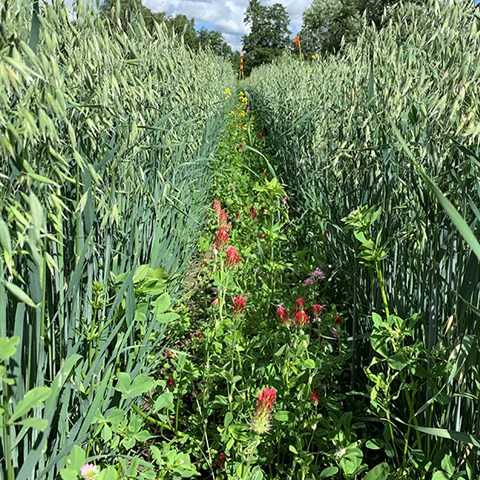Diversification - adding more variety to cropping systems and the agricultural landscape - has been suggested as a path to make agriculture more sustainable. It has the potential to reduce negative impacts from agriculture on climate and the environment. Increasing biodiversity is assumed to enhance yields and ecosystem services such as pollination, pest regulation by natural enemies, nutrient turnover, water quality and climate mitigation through carbon sequestration. Although much research has been invested to explore this, the results of diversification studies have not been synthesized. Further, the focus has mainly been diversification of crops and vegetation. Diversification of soil organisms has seldom been recognized.
“My colleagues and I wanted to test if diversification is beneficial for both agricultural production and ecosystem services. The current trend is that we simplify major cropping systems worldwide. We grow monocultures on enlarged fields in homogenized landscapes. The results of our study indicate that diversification can reverse the negative impacts that we observe in simplified forms of cropping on the environment and on production itself,” says Dr. Giovanni Tamburini at the Swedish University of Agricultural Sciences and lead author of the study.
Based on 5,188 studies with 41,946 comparisons between diversified and simplified agricultural practices, an international team of researchers show in a recent article in Science Advances that overall, diversification measures enhanced ecosystem services. Diversification practices generally maintained at the same level or even increased crop yields. The enhanced biodiversity created by diversification practices improved pollination and pest regulation by natural enemies. It also improved water regulation and enhanced soil fertility. Diversification practices had variable effects on climate regulation. In some cases, diversification increased greenhouse gas emissions.
“An important next step is to identify which specific practices and conditions that result in positive or negative climate mitigation, and to avoid practices that give negative impacts”, says Sara Hallin at the Swedish University of Agricultural Sciences and a co-author of the study.
Studies where yield had been examined together with one or more other ecosystem services were few but still numerous enough to analyze the occurrence of win-win, trade-off and lose-lose situations. Win-win outcomes between yield and another service dominated with 63 per cent of the cases, but all other possible outcomes were also represented.
“There was a clear majority of win-win situations. But there were also less desirable outcomes that we need to avoid when diversifying cropping systems. Agricultural researchers, specialists and farmers need to get together and identify, develop and implement winning combinations of diversification practices”, says Riccardo Bommarco at the Swedish University of Agricultural Sciences and a co-author of the study.
Many of the tested diversification practices are already in use, but could be more widely adopted and used in combinations both on and around crop fields.
Contact persons
Giovanni Tamburini, University of Bari, Italy, giovanni.tamburini@uniba.it
Sara Hallin, Professor at the Department of Forest Mycology and Plant Pathology, Swedish University of Agricultural Sciences, sara.hallin@slu.se
Riccardo Bommarco, Professor at the Department of Ecology, Swedish University of Agricultural Sciences, riccardo.bommarco@slu.se
Claire Kremen, University of British Columbia, Vancouver, Canada, ckremen@zoology.ubc.ca
Matt Liebman, Iowa State University, Iowa, USA, mliebman@iastate.edu
Marcel van der Heijden, Agroscope, Switzerland, marcel.vanderheijden@agroscope.admin.ch
Thomas Cherico Wanger, Westlake University, China, tomcwanger@gmail.com
The article
Giovanni Tamburini, G., Bommarco, R., Wanger, T.C., Kremen, C., van der Heijden, M.A., Liebman, M. and Hallin, S. 2020. Agricultural diversification supports multiple ecosystem services without compromising yields. Science Advances 6:eaba1715
https://doi.org/10.1126/sciadv.aba1715
Press image
(May be published without charge in articles about this press release, please acknowledge the photographer)
Sowing flowering legumes in cereal crops is a way to add diversity to agricultural fields. Here crimson clover, Persian clover and squarrose clover have been sown in oats. In this experiment, SLU researchers investigated whether undersown legumes can promote various ecosystem services, such as pest control provided by natural enemies. Photo: Anna Lundmark
